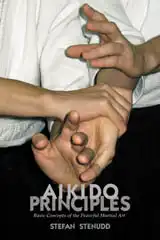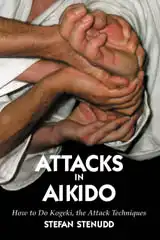Ikkyo Complete 9 Jodori — Defense against jo (staff) attacksJodoriJodori, aikido techniques against jo staff attacks, have their main difficulty in the solid two-hands grip uke has of the jo. Also, the long reach of the jo makes it tricky for tori to enter well in the first step. For jo basics, see here: aikibatto/jo
JodoriJodori ikkyo, omote and ura, on all the attack forms explained below. Many more aikido videos on my YouTube Channel.
Whether the attack with the jo is a tsuki or uchi strike makes less of a difference for the aikido technique, than the grip mentioned above. On this video clip, the attack is tsuki, but ikkyo would be done the same way on most uchi attacks where uke's grip on the jo is the same. The jo is not sharp like the sword, so it is safe to grab. This should be done right after the first evasive taisabaki movement. The best is if tori grabs and pulls the jo before the tsuki attack is completed. That way, uke's forward move is extended and used to commence the ikkyo technique. Make sure to get a wide grip with both hands on the jo, and use it to do the ikkyo. Don't bother to grab uke's arm. Make the ikkyo with the jo instead. Uke should be very reluctant to let go of the jo, as of any weapon. Uke's inner hand grip of the jo is released at the downward turn of the ikkyo. The other hand is released at the end. There are several ways of doing the release. I use leverage, similarly to the release of the sword in tachidori. Keep uke's arm fixed on the ground, while making a circular turn with the jo. Uke should hold on to the jo, for tori to learn to do the release correctly. The initial step of ura is the same as for omote. Only after the jo is grabbed and pulled, does tori decide to do omote or ura. Again, do the technique with the jo, and don't bother to grab uke's arm. Both omote and ura are on the video clip.
Chokutsuki — innner There are many ways to do aikido techniques on jo attacks. Here is a variation on the chokutsuki ikkyo, where tori enters on the other side of uke, and does the ikkyo on uke's inner arm, the one closer to uke's body. This can be done because uke grabs the jo with both hands.
There are many ways to do aikido techniques on jo attacks. Here is a variation on the chokutsuki ikkyo, where tori enters on the other side of uke, and does the ikkyo on uke's inner arm, the one closer to uke's body. This can be done because uke grabs the jo with both hands.You should not try to reach for uke's inner hand, but pull it out by use of the jo. Pull the jo to your side, immediately after you have entered. That way, uke's inner hand moves forward, and you can easily grab the jo near it. Dont grab uke's arm — just the jo, with both your hands. When you make the ikkyo turn, uke will be quite locked. One of uke's hands is released from the jo as you continue the ikkyo. The other hand you must release differently from the outer chokutsuki above — because of the position of uke's grip at the end of the jo. The way I do it, I keep uke's arm extended and uke's hand fixed to the floor, and lift the other end of the jo. It's a leverage thing, again. Ura starts the same way as omote. After grabbing the jo with both hands, tori chooses to do omote or ura. Both omote and ura are on the video clip.
Kaeshitsuki Kaeshitsuki, also called gyakutsuki, is the reverse grip strike, where the little finger of the front hand is forward. In the technique ikkyo this acutally makes little difference, but in some other aikido techniques it changes things quite a lot. So, although ikkyo works fine on both chokutsuki and kaeshitsuki, both should be trained, to get used to both grips.
Kaeshitsuki, also called gyakutsuki, is the reverse grip strike, where the little finger of the front hand is forward. In the technique ikkyo this acutally makes little difference, but in some other aikido techniques it changes things quite a lot. So, although ikkyo works fine on both chokutsuki and kaeshitsuki, both should be trained, to get used to both grips.Ikkyo on kaeshitsuki is slightly easier than on chokutsuki, because uke gets more snared by the jo in the former. It's sort of half-way to a sankyo on uke's wrist, because of the reverse grip on the jo. Also the release is easier, since uke has very little of the grip left by the end of the ikkyo movement. Both omote and ura are on the video clip.
Yokomenuchi The yokomen attack can be done with the chokutsuki or the kaeshitsuki grip, that is with a straight or reverse grip on the jo. On this video clip, the reverse grip is used.
The yokomen attack can be done with the chokutsuki or the kaeshitsuki grip, that is with a straight or reverse grip on the jo. On this video clip, the reverse grip is used.Tori starts by the same kind of entrance and parry as on unarmed yokomenuchi, on katadori, gyakuhanmi katatedori et cetera. It's important to step in close to uke, to avoid getting hit by the jo. Uke's two-hands grip on the jo is strong, and uke's position after the yokomenuchi is quite stable. Therefore it is necessary to extend uke forward, when initiating the ikkyo movement. It's not necessary to pull uke much forward, just a little will suffice. But the movement can't start right at uke. Bring uke's arm slightly forward and then around for the ikkyo technique. Don't bring the arm down too much, before doing the ikkyo, or you may have trouble getting it up again. Just like with any other ikkyo, ura starts the same way as omote. Only after you have grabbed the jo do you decide between omote and ura. Both omote and ura are on the video clip.
Stefan Stenudd
IKKYO COMPLETE
AIKIDO PRACTICEIntroductionAikido Techniques — all the basic movesAttacks in Aikido
Tantodori — knife defenseAikiken — aikido sword techniquesJo 31 Kata in four directionsAikibatto sword and staff exercisesAiki — joining energiesKi exercisesAikido Video ClipsAikido PhotosMy aikido dojo in Malmö, SwedenMy aikido seminarsAIKIDO THEORYMy Aikido BioAikido GlossaryTanden, the CenterAikido InksAikido as Self-DefenseRunning a DojoAikido is TrueOsensei and EinsteinAikiWeb ColumnsAikido Books ReviewedDie deutsche Version meines Aikido-Buches onlineAikido på svenskaAbout CookiesMy Other WebsitesCREATION MYTHSMyths in general and myths of creation in particular.
TAOISMThe wisdom of Taoism and the Tao Te Ching, its ancient source.
LIFE ENERGYAn encyclopedia of life energy concepts around the world.
QI ENERGY EXERCISESQi (also spelled chi or ki) explained, with exercises to increase it.
I CHINGThe ancient Chinese system of divination and free online reading.
TAROTTarot card meanings in divination and a free online spread.
ASTROLOGYThe complete horoscope chart and how to read it.
MY AMAZON PAGE
MY YOUTUBE AIKIDO
MY YOUTUBE ART
MY FACEBOOK
MY INSTAGRAM
MY TWITTER
STENUDD PÅ SVENSKA
|

 Aikido Principles
Aikido Principles Attacks in Aikido
Attacks in Aikido Aikibatto
Aikibatto
